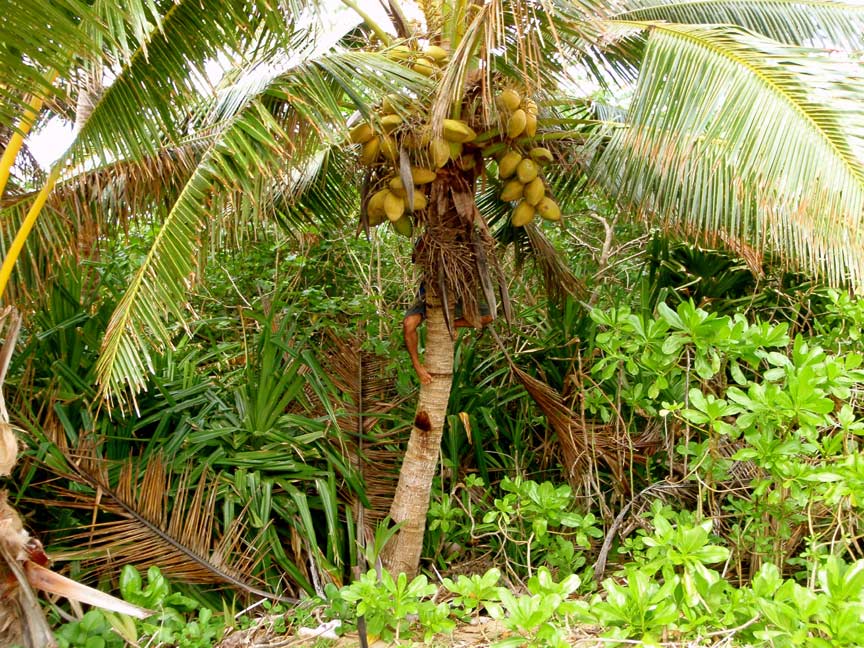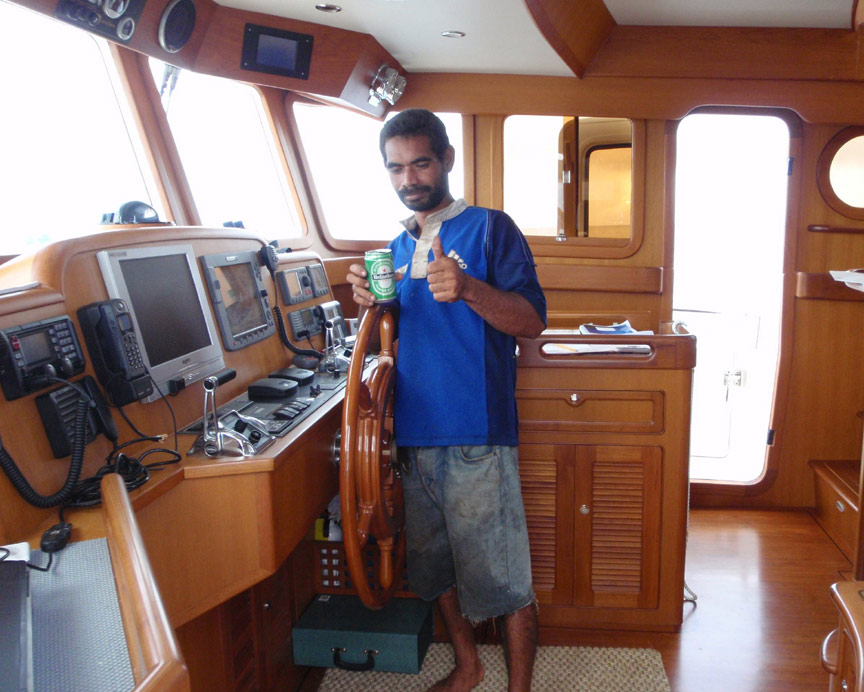Fishing Pigs and an Island Fruiting - Ha'afeva Island, Ha'apai, Tonga

Harmonie
Don and Anne Myers
Fri 5 Jun 2009 06:32
|
19:57.167S 174:42.271W
On May 23, after one night in our bouncy Nomuka Iki
anchorage, we left and sailed a quick 25 miles north to Ha'afeva Island in the
Ha'apai group. We chose this particular island because we knew more of
that Tongan unsettled weather was headed our way and Ha'afeva is one of the few
islands in the Ha'apai group that offers shelter from almost all wind
directions....as long as you don't mind moving your boat from one side of the
island to the other when the wind shifts from east to west and vice versa.
This was a popular spot as most of the boats in the area had the same
idea. Aside from Storyteller, Lady Kay and ourselves, there were about
five other ICA rally boats along with one or two others.
We stayed on one side or the other of Ha'afeva
Island for four nights (one night on the west side, then three on the east
side). The Tongans that live in the village on the east side of the island
must have wondered just a little about the parade of boats motoring from the
west side to the east side, then back to the west side and back
to the east side again over the course of those four days.
Although, most Tongans seem to be pretty savvy when it comes to boating so they
probably understood. Our second night there, which was exactly one week
after the big wind at Pangaimotu Island, we went through another night of
shifting winds that blew up to the howling stage every now and then throughout
the night. It wasn't nearly as bad as our Pangaimotu Island experience,
but didn't make for good sleeping. An occasional wakeful night seems to be
the price we have to pay in order to live the way we do. Somehow, I think
we will manage.
We didn't see much of the sun during our Ha'afeva
Island stay, but we did brave the elements (clouds) one day and went for a hike
around the island. Aside from a few young, towering volcanic islands, most of
the islands in the Tongatapu and Ha'apai groups are very old volcanic dots
of land that have sunk over time and been taken over
by coral. The result is flat, palm tree covered islands with sandy
soil and coral reefs extending out menacingly from most shorelines.
Menacing only because our charts are off by a good quarter mile, which
makes navigation a bit of a trick especially when the sun is nowhere to be
found. Sun or no sun, when we are approaching an anchorage, Don always
sends me up to the bow to act as his early warning system for reefs and coral
head hazards. I do this by using eyeball bow navigation skills
followed by the shout and gesture information relay method. This involves
me and my eyes, watching for changes in the water color ahead and then
relaying any intelligence gained back to Don via shouts and gestures.
This is no problem when the sun is out and I can actually see
something. With a good sun overhead, shallower water is lighter blue,
turquoise or green, and reefs just below the surface of the water are an
ugly brown. When I see something of interest ahead I yell back to Don, 'Do
you see that shallow area to the right? It's turquoise!'. Don
usually responds affirmatively that yes, he sees it. If a particularly
ugly patch of brown is directly ahead of us, then the gesture information relay
method kicks in. 'Turn to starboard! Hard!' I yell while
pointing wildly to the right. This is usually followed by the information
affirmation step which goes like this, 'Did you hear me? I shout at a
decibel level slightly higher than before. This, of course, is out of my
mouth before I realize that the boat is indeed turning to starboard and
it's obvious that the captain heard and understood my shouting and wild
gesticulation. When it's cloudy, all eyeball bow navigation bets are
off. The water looks almost steel gray, regardless of the depth or what's
under the surface. Breaking waves are our only saving grace in these
circumstances. At least breaking waves over a reef area can
still be seen on a cloudy day. Other than breaking waves, my eyeball
bow navigation skills on a cloudy day are reduced to the shout
information relay method, which consists of one simple message,
'I CAN'T SEE ANYTHING!' This is usually not a pleasant
circumstance when we are motoring our way into a tricky anchorage.
Fortunately for us, we have not grazed a single reef, coral head or rock so far
in our travels. I like to think this happy result is due to my superior
eyeball bow navigation and shout and gesture information relay skills, but
somehow I think the captain might have more to do with it.
Back to our hike around Ha'afeva. Four of us,
John and Sue from Storyteller, Don and myself, dinghied in to the crumbling
concrete wharf near the village where we were greeted by an extended family of
fishing pigs. Yup, fishing pigs. Lolo pointed a few of these beasts
out to us when we were on our tour of Tongatapu Island and at the time we
thought fishing pigs were exclusive to Tongatapu. Not so. It seems
Tongan pigs everywhere are particularly intelligent and have figured out
that good fish and other edibles can be had when the tide goes out. All it
takes is a bit of routing around, which all pigs seem to be good at.
Picture 1 - Fishing pigs and their human
masters routing around at low tide. Note the clouds and steel-gray colored
water.
We walked through the village which we were to find
out later houses about 100 people. At the time we were surprised at the
number of churches (four), but were even more surprised after we learned they
serviced only 100 people. The village had a medical clinic, a
school and a few tiny little shops in addition to the churches, but that was
about it. All the people were friendly, waving at us as we passed
by. The little kids were extremely interested in us palangi
(foreigners), and seemed to take great pleasure in waving madly and yelling
'Hello!' and 'Bye bye!' to us as we walked by.
We left the village and followed a trail through
the bush that eventually took us to the other side of the island. There
were a couple of tense moments when we thought we were lost, but we could hear
the surf on the beach and decided the island was so small we would really have
to work harder at getting lost. On the beach we ran into three or four
Tongan men who seemed to like practicing their English on us. One of
them, Peter, offered to get us some fruit, which by this time we were all short
of, so we diligently followed him along the beach and back into the bush.
Shortly thereafter, Peter asked if we would like a drinking nut. We agreed
and he immediately shimmied up a palm tree to cut down four green coconuts for
us with his machete.
Picture 2 - Peter shimmying up the palm tree in
search of drinking nuts. Note his legs wrapped around the tree
trunk.
Picture 3 - Peter with his trusty machete and
coconut in hand.
After our refreshment break, we continued on into
the bush and proceeded to be fruited. First there were papayas. Two
for Sue, two for me. Then came the lemons - huge, with thick green skins
and an incredibly fragrant lemony scent. Twelve for Sue, twelve for
me. Then a couple of chunks of sugarcane (what exactly do you do with a
chunk of sugarcane?). One for Sue, one for me. We asked Peter what
he would like in return for the fruit, but he refused to take any money.
Instead, he indicated that he would like to come out with us in the dinghy to
see our boats. Ok, fair enough. We trudged back through the bush to
the village, Don and John loaded down with the fruit. We took Peter first
to Storyteller, where John felt it was only polite to ask Peter if he
wanted a beer since the rest of us were having one. Peter enthusiastically
accepted the beer, a surprise to us since one of the main churches in the
village is Mormon. Peter then asked if we would take his picture at
the wheel of Storyteller, which we did (picture 4).
A half hour later, we decided it was time to get
Peter back to land. John and Sue packed a gift bag for Peter containing a
flashlight, a few other goodies and another beer. Peter immediately opened
the beer (with his teeth I might add) and started slugging it down. Our
collective eyebrows went up, but we carried on and got Peter into the dinghy
with Don and I, and zipped over to Harmonie. Once on board, Don printed
out the picture of Peter at the wheel of Storyteller while I offered Peter
another beer. By this time he had finished his second and gladly took a
third. Shortly thereafter, the picture was ready for Peter and Don
indicated it was time to get Peter back to shore. 'Another beer?'
Peter asked. Hmmmm....'Ok, one for the road.' we said. Peter chugged
the third beer down and took the fourth. Don guided him into the dinghy
(Peter needed guidance by this point) where Peter promptly
cracked open the fourth beer (again with his teeth). As they
passed Lady Kay, Peter asked Don if they could stop to see the boat.
Catching on to Peter's beer begging gig, Don firmly said no and took Peter back
to the crumbling concrete wharf. Before they reached the wharf (a three
minute dinghy ride) Peter had finished his fourth beer and was decidedly
tipsy. It seemed he didn't want anyone on shore to see him drinking and
hence the rush to get it down. We don't normally offer alcohol to the
island people, but in this case it seemed impolite not to, especially after the
fruiting we received. Hopefully Peter didn't get himself into any trouble,
and hopefully he enjoyed his brief stint at the wheel of the mighty trawler
Storyteller.
Since then Sue and I have done our best to come up
with ways to use the lemons we received as part of our fruiting. One
of our favorite methods involves a huge amount of heavy cream, sugar, lemon
juice, a lot of whipping and a freezer. Better than ice cream and
probably not nearly as healthy.
Lemonade anyone?
Anne
|



